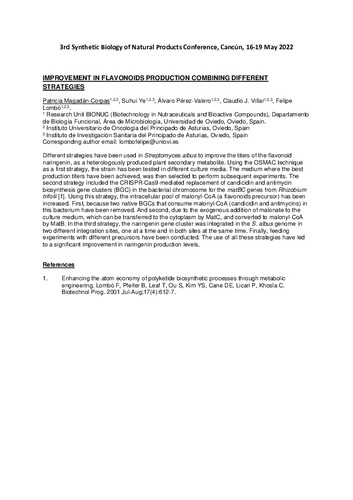Improvement in flavonoids production combining different strategies
Autor(es) y otros:
Fecha de publicación:
Resumen:
Different strategies have been used in Streptomyces albus to improve the titers of the flavonoid naringenin, as a heterologously produced plant secondary metabolite. Using the OSMAC technique as a first strategy, the strain has been tested in different culture media. The medium where the best production titers have been achieved, was then selected to perform subsequent experiments. The second strategy included the CRISPR-Cas9-mediated replacement of candicidin and antimycin biosynthesis gene clusters (BGC) in the bacterial chromosome for the matBC genes from Rhizobium trifolii [1]. Using this strategy, the intracellular pool of malonyl-CoA (a flavonoids precursor) has been increased. First, because two native BGCs that consume malonyl-CoA (candicidin and antimycins) in this bacterium have been removed. And second, due to the exogenous addition of malonate to the culture medium, which can be transferred to the cytoplasm by MatC, and converted to malonyl-CoA by MatB. In the third strategy, the naringenin gene cluster was integrated in the S. albus genome in two different integration sites, one at a time and in both sites at the same time. Finally, feeding experiments with different precursors have been conducted. The use of all these strategies have led to a significant improvement in naringenin production levels.
Different strategies have been used in Streptomyces albus to improve the titers of the flavonoid naringenin, as a heterologously produced plant secondary metabolite. Using the OSMAC technique as a first strategy, the strain has been tested in different culture media. The medium where the best production titers have been achieved, was then selected to perform subsequent experiments. The second strategy included the CRISPR-Cas9-mediated replacement of candicidin and antimycin biosynthesis gene clusters (BGC) in the bacterial chromosome for the matBC genes from Rhizobium trifolii [1]. Using this strategy, the intracellular pool of malonyl-CoA (a flavonoids precursor) has been increased. First, because two native BGCs that consume malonyl-CoA (candicidin and antimycins) in this bacterium have been removed. And second, due to the exogenous addition of malonate to the culture medium, which can be transferred to the cytoplasm by MatC, and converted to malonyl-CoA by MatB. In the third strategy, the naringenin gene cluster was integrated in the S. albus genome in two different integration sites, one at a time and in both sites at the same time. Finally, feeding experiments with different precursors have been conducted. The use of all these strategies have led to a significant improvement in naringenin production levels.
Descripción:
Synthetic Biology of Natural Products Conference (3rd. 2022. Cancún, México)
Colecciones
- Biología Funcional [775]
- Pósteres [94]
Ficheros en el ítem





